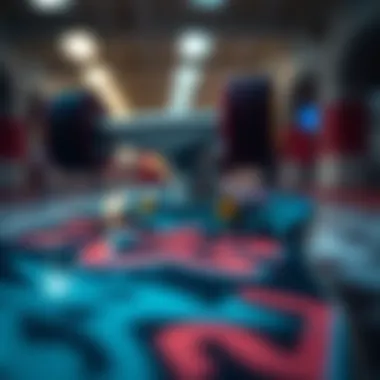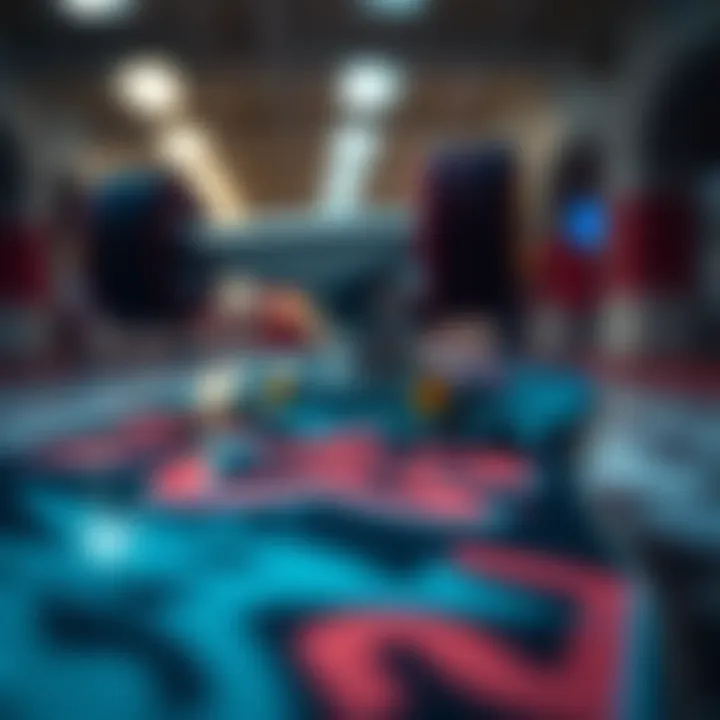Comprehensive Guide to Mini Logo Skateboards


Intro
Skateboarding, a blend of art, sport, and culture, has evolved in ways that many might not recognize. Mini logo skateboards, with their compact frames and unique designs, hold a special place in this world, attracting both beginners and seasoned riders alike. These boards are not just smaller versions of their traditional counterparts; they embody a philosophy, a way of life for those who ride them. This guide aims to dissect every facet of mini logo skateboards, delivering a comprehensive understanding that can greatly enhance your skating journey.
Whether you're a novice seeking guidance in the basics or an experienced skater looking to refine your skills, this article is tailored just for you. You’ll find insight on technique, gear, and how mini logo skateboards integrate into the broader skateboarding culture. Join us as we navigate this fascinating realm, arming you with the knowledge to choose, maintain, and improve your skating experience.
Prologue to Mini Logo Skateboards
Mini logo skateboards occupy a significant niche in the diverse realm of skateboarding. They are compact, versatile, and designed with skaters of all skill levels in mind. An understanding of mini logo skateboards can tailor both your riding experience and purchasing decisions. They're not just smaller versions of traditional skateboards—they represent a philosophy of accessibility and practicality in skating.
For starters, mini logos are often favored for their lightweight construction. This feature makes them incredibly maneuverable, a key trait for tricks and street skating, where agility is the name of the game. They allow riders to perform intricate moves with a precision that larger boards sometimes hinder. So, if you're eyeing that perfect ollie or want to nail a kickflip off a ledge, a mini skateboard might just be the right fit for you.
Additionally, the compact size often means enhanced portability. For skaters who find themselves commuting or hopping on a bus, these smaller boards fit nicely under an arm or into narrower spaces. The practicality layer doesn't stop there; for those more seasoned skaters who appreciate customizability, a mini logo skateboard opens the door to trying out various components without breaking the bank on larger setups.
These boards also afford a unique opportunity for budding skaters. Many amateurs find the feel of a mini logo far less intimidating, encouraging them to practice more frequently. This confidence-building aspect can't be underestimated. As beginners feel comfortable on their boards, they naturally progress and take on more challenges.
Moreover, let's not gloss over the aesthetic appeal. Mini logos often come in vibrant designs that resonate with youth culture, making them an appealing choice for younger skaters or those who care about how their gear looks.
Understanding mini logo skateboards thus gives riders a broader perspective on both the sport and themselves. It helps in choosing the right board, understanding maintenance requirements, and even connecting with a community of like-minded individuals who cherish the experience of skating. Whether you're diving in for the first time or you're a seasoned pro revisiting, mini logo skateboards present a wealth of options to ensure that every ride is satisfying.
"In the world of skateboarding, size matters, but not in the way you might think. Mini logo skateboards provide freedom and versatility that larger boards sometimes can't offer."
By focusing on what mini logo skateboards bring to the table, skaters can better appreciate this often-overlooked component of skating culture. It is this comprehension that we will explore further, unraveling not just their features, but their role in the greater skateboard community.
History and Evolution of Mini Logo Skateboards
The history and evolution of Mini Logo skateboards offer a fascinating lens through which to examine not just the boards themselves, but also the entire skateboarding culture. This topic is vital because it showcases how these boards have transformed and adapted over time, reacting to changing techniques, rider preferences, and advances in material and design technologies. Understanding this evolution helps skateboarders appreciate the gear they use daily and empowers them to make informed choices in their skating journey.
Origins of Mini Logo Design
The roots of Mini Logo skateboards can be traced back to the broader evolution of skateboard design. Originally, skateboards were not much more than wooden planks with wheels attached. However, as skating gained traction in the 1960s and ‘70s, innovation kicked in. The introduction of better materials, like fiberglass and later, specially engineered plastics, led to stronger but lighter boards.
Mini Logo, as a brand, emerged in the late '90s, the time when skate culture was maturing, and riders began seeking gear that offered both performance and affordability. Traditionally, skateboard companies invested heavily in marketing, focusing on flashy graphics and endorsement deals. Mini Logo sidestepped this trend by offering functional and budget-friendly options that did not compromise on quality. This stripped-down approach aligned with the ethos of many dedicated skaters who valued functionality over frills.
What took Mini Logo a step further was the keen eye for detail in their designs. The logo itself, bold yet understated, became an emblem for a community that favored substance over style. Their boards marked a turning point—a move towards appreciating skateboards as tools designed to enhance performance, rather than just as art pieces. This focus on the essentials appealed to novice and experienced skaters alike, establishing Mini Logo as a legitimate player in the market.
Development Over the Years
Over the years, Mini Logo skateboard designs have evolved significantly, reflecting changes in both skateboard technology and rider preferences. At first, the boards were relatively standard in shape and size, but growing demands for diversity led to a variety of shapes that cater to different styles of skating—from street to vert.
The development of materials also played a sizeable role. The original mini logo boards were made with simple maple wood; however, as technology progressed, manufacturers began to experiment with materials like bamboo and composite materials. These innovations not only enhanced strength but also lightened the boards, making them more maneuverable—an essential aspect for tricks and complex riding styles.
In response to the increasing popularity of skateboarding among younger generations, Mini Logo began to include graphs inspired by skate culture and lifestyle, balancing the original no-frills approach with a bit more personality. This was a smart move as it connected with a broader audience while still keeping true to the brand's reputation for quality.
"A good skateboard is like a good pen; it ought to feel comfortable and precise, reflecting the rider's individuality every time they hit the pavement.”
Today, Mini Logo skateboards maintain a devoted following, partly due to their commitment to high standards of durability, performance, and affordability. As the industry continues to grow and adapt to new trends, Mini Logo remains a strong contender in the skateboard scene, perpetually evolving to meet the demands of both seasoned pros and newbies alike.
In summary, the history and evolution of Mini Logo skateboards underscore a broader narrative within the skateboarding community—one that values quality, authenticity, and user experience over mere hype. As skaters continue to push boundaries, knowing where these boards started and how they’ve changed over time adds depth to the appreciation of this beloved sport.
Understanding Complete Skateboards
When it comes to delving into the world of skateboarding, grasping the essence of complete skateboards is paramount. A complete skateboard is not just a set of acclaimed components; it’s an amalgamation of parts that work in harmony to deliver smooth rides, tricks, and flips. This understanding is essential for novice skaters and veterans alike, as it informs purchasing decisions, enhances riding experiences, and promotes safety.
Definition of Complete Skateboards
A complete skateboard is often defined as a pre-assembled skateboard that comes ready to ride right out of the box. It includes all the vital components that one needs: the deck, trucks, wheels, bearings, and grip tape. Each of these elements has its own role to play in ensuring a seamless functionality of the skateboard. For someone just stepping into the realm of skateboarding, a complete set can simplify the decision-making process, allowing them to focus more on honing their skills than piecing together their setup. Without the need for customization, it’s an ideal starter kit.
Components of a Complete Board
The importance of each component in a complete skateboard cannot be overstated. Let’s take a closer look.
Wheels
Wheels are a vital aspect that dictate how the skateboard interacts with different surfaces. Typically made of urethane, these wheels deliver durability and a level of grip essential for various terrains. A key characteristic of quality wheels is their hardness rating, measured on a durometer scale. Softer wheels absorb bumps and provide a smoother ride, while harder wheels are suitable for tricks and skate parks. One unique feature of skateboard wheels is the variety of shapes and sizes available, catering to different skating styles. However, novice skaters might find it advantageous to start with softer wheels for better grip when learning.
Trucks
The trucks serve as the pivot point for turning and tricks. They are usually made from metal and attach to the deck, supporting the skateboarders' weight while enabling turns. A noteworthy feature of trucks is their width, which should correspond to the width of the deck for optimal stability. Lightweight trucks allow for better maneuverability during tricks, making them a popular choice among skaters. However, it’s crucial to choose trucks that are neither too tight nor too loose, as that can hinder control.


Deck
The deck is essentially the platform where the skater stands. Made from layers of maple wood or more recently, bamboo, the deck’s construction impacts durability and flexibility. A key characteristic is its width and length, which significantly affects balance. Wider decks offer more stability, ideal for beginners, while narrower decks facilitate executing tricks. A unique disadvantage of some decks is the potential for wear and tear, especially when used extensively in various environments.
Bearings
Bearings are the small round parts that allow the wheels to spin freely around the axle. The quality of bearings can directly influence the performance of the skateboard, enabling smoother rides and faster speeds. Rated on the ABEC scale, a higher rating indicates a precision that leads to faster movement. However, more expensive bearings might not always equate to better performance for beginner skaters, as they can often be more than needed for entry-level riding.
Grip Tape
Grip tape is a gritty surface applied to the top of the deck that provides traction for the skater’s feet. This element is crucial in preventing slips during intricate maneuvers. A major selling point for grip tape is its ability to withstand wear while still maintaining its adhesive properties. Most grip tape comes with a coarse texture, ensuring skaters have a secure footing during tricks. However, a notable downside is that the adhesive can sometimes damage the deck's surface when removed.
Understanding these fundamental components of complete skateboards can aid both newcomers and experienced riders in making informed decisions. Knowledge of what shapes, sizes, and materials suit one’s style can elevate one’s skating experience and safety.
Features of Mini Logo Skateboards
Mini Logo skateboards are not just toys for kids; they embody a thoughtful mix of design elements and functionality that cater to a broad spectrum of riders, from novices to pros. Understanding the features of these skateboards is crucial for anyone looking to step up their game or simply enjoy the ride. Here, we’ll cover the important aspects that distinguish Mini Logo skateboards, breaking down dimensions, construction materials, and weight considerations.
Dimensions and Sizes
When it comes to skateboards, size does matter. Mini Logo skateboards come in various dimensions, offering riders choices that best fit their style and experience. Typically, the width of a Mini Logo board ranges from 7.5 to 8.25 inches, and lengths vary, often falling between 28 to 32 inches.
- Narrower boards excel in technical tricks due to quicker flips and easier turns. Ideal for street skating, these boards allow for better maneuverability in tight spaces.
- Wider boards, on the other hand, provide stability and comfort when cruising or doing larger tricks, making them suitable for park riders or those new to skateboarding.
Finding the perfect width for a board is not just about aesthetics; it’s about how well it aligns with the rider's foot size and preferred riding style. No two skaters are alike. Smaller riders might prefer a board on the narrower end while heavier skaters might opt for a wider option.
Material Construction
The backbone of any skateboard lies in its material. Mini Logo skateboards generally feature a hard maple construction, praised for its strength and durability. Unlike cheaper materials, maple can withstand significant wear and tear, crucial for those learning or pushing their limits.
The construction often involves:
- 7-Ply Maple: This is the standard for many skateboards. It provides the right balance of stiffness and flexibility.
- Bamboo or Fiberglass: Some models may incorporate these materials, enhancing performance by allowing for a lighter feel while still maintaining strength.
- Grip Tape Quality: A solid layer of grip tape on top boosts traction, ensuring that the rider’s feet stay put during tricks and rides.
Moreover, the finish of the board not only contributes to its aesthetic appeal but also affects its performance. A smooth finish can reduce friction, making for faster rides, while detailed graphics can add that personal touch.
Weight Considerations
Weight is another pivotal feature when choosing a Mini Logo skateboard. A heavier board often provides more stability, whereas a lighter one can facilitate easier tricks and transportation. A healthy range for Mini Logo skateboards is about 2.5 to 4.5 pounds.
- Lightweight Boards: These are fantastic for tricks and flips, especially for riders who prioritize agility. However, they might lack stability when cruising.
- Heavier Boards: These usually feel more robust and are better for those engaging in downhill rides or heavier tricks. They’re less prone to losing control during intense maneuvers.
"The right skateboard can dramatically influence the learning curve for new skaters and performance for veterans. Don’t underestimate the importance of features."
For more information on different materials and their benefits, you can check out Skateboard Materials Insights and The Evolution of Skateboard Design.
Integrating these features not only enhances riding experience but also contributes to skills development, making the Mini Logo skateboard a worthwhile choice.
Popular Brands and Their Offerings
The realm of skateboarding is marked by a diverse array of brands, each boasting unique traits that cater to the preferences of different skaters. Understanding popular brands and their offerings is crucial not just for choosing the right board but also for grasping the underlying quality and innovation that define the skateboarding experience. The right choice can significantly impact a skater’s performance and enjoyment, making this a vital segment of the guide.
Mini Logo Brand Insight
Mini Logo is not just a brand; it is a beacon of accessibility and performance in the skateboarding community. Known for its high-quality materials and affordability, Mini Logo makes skateboarding inclusive for beginners and professionals alike. Their boards are designed with the skater's needs in mind, making them a popular choice for those wanting to balance cost with performance.
What sets Mini Logo apart is their commitment to utilizing premium materials without premium pricing. The decks often feature 7-ply construction, which provides durability while remaining lightweight. This balance ensures that skaters can express their tricks and style without compromising strength.
In addition to performance, Mini Logo emphasizes creativity. Their various deck sizes and graphic designs allow for a personal touch that resonates with many skaters. Whether you prefer a slick, minimalist look or something vibrant and eye-catching, Mini Logo accommodates a wide range of aesthetic tastes.
Competitors in the Market
While Mini Logo has established itself as a formidable player in the skateboard market, it’s crucial to consider its competitors to understand the broader landscape. Brands like Element, Shorty’s, and Zero offer robust alternatives that cater to specific needs and preferences in riders. Each of these brands brings something distinctive to the table.
- Element focuses heavily on environmental sustainability, using eco-friendly materials in their skateboard construction. Their eco-conscience mission appeals to skaters who are conscious of their environmental impact.
- Shorty’s is known for its loyalty to the street skating scene, frequently collaborating with top pro skaters, ensuring that their products are backed by industry expertise.
- Zero is often recognized for its no-nonsense boards designed for heavy-duty skating. Built to withstand the rigors of aggressive tricks and tough terrains, Zero is preferred by riders who push the limits.
A well-rounded understanding of these brands equips skaters to make informed choices when selecting a complete skateboard. Factors such as design, durability, and brand reputation all play roles in the decision-making process, paving paths for enhanced skating experiences.
"In skating, the right board can change everything. It's not just about comfort; it's about finding your style and connection with the community."
All brands mentioned above contribute to the diversity of the market, and prospective buyers should weigh their options carefully against personal preferences and riding styles. As the industry evolves, staying informed helps skaters navigate their choices wisely, whether they are just starting out or look to refine their gear.


Choosing the Right Mini Logo Skateboard Complete
Selecting the appropriate mini logo skateboard complete is crucial for both novice and seasoned skaters. The right board can enhance your performance, ease your learning curve, and enrich your skating experience. Different factors—such as your skill level, riding style, and budget—play significant roles in making this decision. Understanding these elements allows skaters to choose a board that fits their personal needs, ultimately maximizing enjoyment on the board.
Factors to Consider
Skill Level
Considering your skill level is vital when choosing a skateboard. Various boards cater to different levels of expertise, from beginners figuring out their balance, to advanced riders pulling off tricks. A beginner might benefit from a wider deck, offering better stability as they learn the ropes. On the flip side, advanced skaters often seek narrower boards that allow for technical maneuvering.
- Key Characteristic: The right board for your skill level can prevent frustration and injuries, making your learning curve smoother.
- Unique Feature: Beginners may find that a board with softer wheels is more forgiving on rough surfaces, allowing for a gentler ride in the early stages.
In essence, matching your skill level with the appropriate equipment supports your growth while keeping you safe.
Style of Riding
Your style of riding is another essential consideration. Whether you enjoy cruising in the park, tackling street tricks, or shredding ramps, the board must match this preference. For example, if you are drawn to street skating, a more compact and lightweight board usually suits this style well. Conversely, if you prefer vert skating, a sturdier board provides necessary support for those gravity-defying tricks.
- Key Characteristic: Knowing your riding style ensures that the skateboard performs well in the environments where you intend to use it.
- Unique Feature: A board designed for street skating often features a longer nose and tail, giving riders added pop for tricks.
Understanding if you lean towards street, park, or casual riding is key when making a selection.
Budget
Budget is likely one of the first factors many skaters consider. A reasonable price doesn’t always equate to quality, but setting a budget helps narrow your options in the vast sea of available skateboards. Mini logo skateboards come in a range of prices, which can rise significantly based on brand reputation and components used.
- Key Characteristic: Establishing your budget can help you make informed decisions without feeling overwhelmed by the choices.
- Unique Feature: Sometimes, spending a bit more upfront on a well-constructed board leads to savings in the long run due to durability and lower maintenance costs.
Ultimately, aligning your budget with realistic expectations about quality opens pathways to a satisfying purchase.
Where to Buy
Finding the right place to purchase your mini logo skateboard complete can be half the battle. Local skate shops often provide valuable recommendations and allow for hands-on inspection of the boards. Online retailers can give you access to a wider variety and competitive pricing, but you might miss out on expert advice.
Rounding up options from local sources and online is wise. Consider websites like Skate Warehouse or Tactics, which have extensive inventory and cater to various budgets and skill levels. Additionally, participating in community forums on platforms like Reddit or engaging with fellow enthusiasts on Facebook groups can reveal hidden gems in local shops as well.
Ultimately, taking the time to research and explore both local and online options will lead to a well-informed decision that suits your skating style and preferences.
Maintenance of Mini Logo Skateboards
Keeping your Mini Logo skateboard in tip-top shape goes beyond just riding it. It’s about ensuring longevity and optimal performance while also enhancing your skating experience. Regular maintenance may not be a thrilling tale, but it’s a crucial part of skateboarding that often makes the difference between a smooth ride and a bumpy one. Skaters of all levels must grasp the essentials of upkeep to prevent wear and tear, ultimately saving both time and money.
Cleaning Techniques
A clean skateboard isn't just good for looks; it helps in improving performance too. Here are some methods to keep that deck shining:
- Wipe Down After Each Ride: Grab a damp cloth and give it a quick rub down. This removes dirt and grime that cling like a bad habit.
- Deep Clean Every Month: For a thorough cleanse, remove the grip tape, wheels, and trucks. Use a soft brush, water, and gentle soap to scrub the deck. Avoid abrasive materials; they can scratch your board, ruining it faster than you can say 'ollie.'
- Drying: After cleaning, make sure the board dries completely. No one wants a soggy skateboard—mold is a skater's worst enemy.
While cleaning, pay special attention to the wheels and trucks:
- Wheels: Remove them before cleaning to get rid of dirt and debris that tends to build-up. This will also help in performing better tricks.
- Trucks: Wipe these down regularly as well; they are the backbone of your skateboard. Don’t forget to check for rust, which can sneak in without notice.
Regular Checks and Adjustments
In this sport, you're only as good as your gear allows, which is why checks and adjustments shouldn’t be brushed off.
- Inspect Your Bearings: Spin those wheels! If they feel gritty or aren't rolling smoothly, it’s time for maintenance or replacement.
- Tighten Security: Ensure all bolts and screws are tight. Loose fittings can lead to instability or equipment failure, turning a mediocre ride into a disastrous fall.
- Deck Inspection: Regularly look for cracks or chips in the board. Any significant damage can affect your balance and tricks. If you see splitting or deep scratches, it’s probably time to retire that deck.
- Grip Tape Check: Sometimes overlooked, your grip tape should be replaced when it starts to peel or lose its effectiveness. A slip while doing tricks can lead to injury or accidents.
"Regular maintenance helps you get the most out of your Mini Logo skateboard. Without proper care, you can find yourself stranded on the sidelines while others ride smoothly."
Incorporate these maintenance routines into your skating ritual. Whether you’re a complete beginner or a seasoned vet, a well-maintained skateboard enhances your skills and elevates your overall skating experience.
User Experiences and Testimonials
In the world of skateboarding, personal experiences hold a significant weight. It's not just about the hardware, but how it feels when the wheels hit that pavement. User experiences and testimonials shine a light on the practicality of mini logo skateboards. They inform potential buyers about the realities of what to expect from different models and setups.
Skateboards cater to diverse styles and preferences, and understanding these differences can help skaters make informed choices.
Beginner Skaters' Perspectives


For newcomers to the sport, mini logo skateboards can be a mixed bag of emotions. The initial thrill of gliding on a deck can be magnificent, yet overwhelming due to the challenges involved. Many beginners often share their struggles with balance, coordination, and braking. These honest accounts provide invaluable insight into what first-time riders face.
Some elements that beginner skaters tend to focus on include:
- Size and Maneuverability: Many beginners appreciate the compact size of mini logo boards, which allow for easier pivots and tricks, especially for those still finding their footing.
- Durability: Testimonials frequently mention the need for sturdy components, particularly in terms of decks that can withstand early learning crashes. A few respondents note that lighter boards contribute to better control as they learn.
- Affordability: New skaters often look for budget-friendly options. Responses show a consensus that mini logo boards offer good value without compromising on quality; satisfaction reflects the balance achieved in performance and price.
"Starting out with a Mini Logo made it easier for me. The smaller size felt less intimidating, and it didn’t break the bank!" - A beginner's note on their experience.
Advanced Skaters' Feedback
For seasoned skaters, the perspective shifts dramatically. Advanced users analyze the board's features with precision, regarding aspects such as stability, agility, and performance under varied conditions. These skaters have often tried a range of board types, making their insights particularly compelling.
Key points advanced skaters frequently touch on include:
- Performance: Many advanced users report that mini logo boards can hold their own when it comes to executing tricks or handling rough terrain. They often prefer the versatility these boards provide during complex maneuvers.
- Material Quality: The choice of materials is a big talking point among seasoned riders. They tend to look for high-quality woods and durable truck and wheel combinations that ensure longevity.
- Customization: Experienced skaters appreciate the ability to swap out parts to suit individual preferences, be it wheels or grip tape. Many mention that mini logo sets often allow for easy customization to elevate their skating style.
"The Mini Logo deck was just what I needed: solid underfoot and responsive during my tricks. I keep going back to it." - An advanced skater reflecting on their long-term relationship with mini logo skateboards.
User experiences and testimonials provide both beginner and advanced skaters with relatable insights, making them potent tools for better understanding the vast array of mini logo skateboard options available today.
The Cultural Impact of Mini Logo Skateboards
The influence of mini logo skateboards stretches far beyond their physical design and functionality. The cultural significance of these compact boards shapes not only individual skating experiences but also contributes to the overall skateboarding community. Mini logo skateboards present a diverse array of benefits, highlighting the importance of understanding their role within this culture.
Role in Skateboarding Community
Within the skateboarding community, mini logo skateboards have become synonymous with individuality and expression. They cater to skaters of all ages and skill levels, allowing them to find their footing in a sport traditionally known for its competitive edge. The affordability and versatility of these complete skateboards make them accessible to newcomers looking to join the skate scene.
Moreover, the aesthetic appeal of mini logo designs has carved out a niche in skate culture. These boards often showcase unique graphics and colors, becoming a canvas for creativity.
- Community Building: Mini logo skateboards encourage camaraderie among skaters. Local skate shops frequently host events around them, from competitions to showcases, fostering connections.
- Shared Identity: Through their distinctive designs, these skateboards cultivate a sense of belonging among users. Riders often feel a connection to others who share their preferences for mini logo boards, strengthening social ties within the community.
Influence on Trends and Styles
The impact of mini logo skateboards on trends and styles cannot be understated. As skaters innovate and push the boundaries of tricks and techniques, these boards evolve in response to the dynamic landscape of the sport. Not only do they introduce fresh styles but they also underscore sustainability in their design and materials.
For instance, many riders today are prioritizing eco-friendly options when selecting a skateboard. The growing demand has prompted brands to create boards using renewable resources without sacrificing quality or performance.
- Fashion Statements: Mini logo skateboards often become part of a skater's personal fashion statement, influencing broader streetwear trends. Users frequently pair their boards with specific brands or styles that amplify their image.
- New Generation of Skaters: Younger skaters are picking up mini logo skateboards, integrating them into their viral online presence. Social media platforms play a pivotal role in showcasing mini logo tricks, propelling these boards into mainstream visibility and further shaping style preferences.
Future of Mini Logo Skateboards
The realm of mini logo skateboards is ever-evolving, and understanding its future can provide invaluable insights to both skaters and industry stakeholders. As these skateboards continue to grow in popularity, examining the trends, innovations, and environmental considerations that shape their future is crucial. This section delves into cutting-edge design innovations, the push for sustainability, and the implications of these changes on riding experiences and the broader skateboarding culture.
Innovation in Design
With skateboard technology advancing faster than a downhill race, innovation in design stands at the forefront of the transition to the next wave of mini logo skateboards. Skate companies are always on the lookout for ways to enhance performance and durability, leading to fascinating developments in materials and technology.
For example, carbon fiber decks are not just a pipe dream anymore. They offer increased strength without the added weight, catering to a new generation of skaters who value both performance and portability. Additionally, improvements in the wheel design, such as formula changes for grip and a reduction in noise, signify the dedication of brands to refine every aspect of the skateboard experience.
Skaters can also look forward to advancements in customization. Skateboards are becoming more modular, allowing riders to swap parts based on their unique preferences and riding styles. This adaptability and personalization reflect a shift towards catering to individual expression, which is vital in a community that values personal style and street culture.
Environmental Considerations
As the world stands on the cusp of a climate crisis, the skateboard industry is responding with a green thumb approach. Sustainability has become a buzzword, and for good reason. Brands are beginning to recognize that healthy ecosystems and skateboarding can coexist. This means using sustainable materials like bamboo, which is not only sturdy but also a renewable resource. Furthermore, manufacturers are exploring biodegradable grip tapes and non-toxic paints, contributing to a healthier planet.
The shift towards eco-friendly processes doesn’t just satisfy ethical considerations; it also appeals to a younger, environmentally conscious demographic. These decisions resonate with consumers looking to support brands that align with their values. Moreover, initiatives to curtail waste in manufacturing processes highlight a proactive stance, creating an industry that aims to reduce its carbon footprint.
"The future of skateboarding is not solely about performance but also about preserving our planet for generations of skaters to enjoy."
Epilogue
In wrapping up our exploration of mini logo skateboards, it’s paramount to recognize the multi-faceted importance of these compact boards within the skateboarding realm. Not only do they cater to a diverse range of skaters—from enthusiastic beginners to seasoned pros—but they also embody the essence of innovation and adaptability in design.
One crucial element is the emphasis on understanding how to choose the right mini logo skateboard complete. Skaters need to reflect on their skill levels, preferred styles, and budget constraints. A well-informed choice means the difference between a fulfilling skating experience and one riddled with frustration. The right board can significantly enhance skill development, making learning smoother or allowing experienced skaters to push their limits.
The benefits of mini logo skateboards extend beyond just functionality. Their lightweight composition and tailored dimensions make them ideal for urban environments where maneuverability is key. Moreover, they often cater to the aesthetic inclinations of skaters, reflecting personal style while offering reliable performance.
When considering future purchases or upgrades, one should pay heed to the cultural implications and market trends presented earlier. These boards not only serve as practical equipment but also as vessels of expression and identity within the skateboarding community.
"Skateboarding is not just a sport, it’s a lifestyle that embraces creativity and individuality."
As we have discussed, maintenance also deserves a spotlight. Keeping your mini logo board in top-notch condition prolongs its life and plays a crucial role in safety. Regular checks and cleaning ensure that users can enjoy their boards fully without the risk of mishaps.
Lastly, the evolving nature of the skateboarding industry hints at constant innovation. Observing how brands improve their offerings and respond to feedback can guide future purchases and shape one's approach to skateboarding.
Overall, the conclusion encapsulates the journey of understanding mini logo skateboards—highlighting their significance in skill acquisition, creative expression, and community involvement. As skaters navigate their path, being well-informed empowers them to make astute choices that enhance their lifetime enjoyment of the sport.







